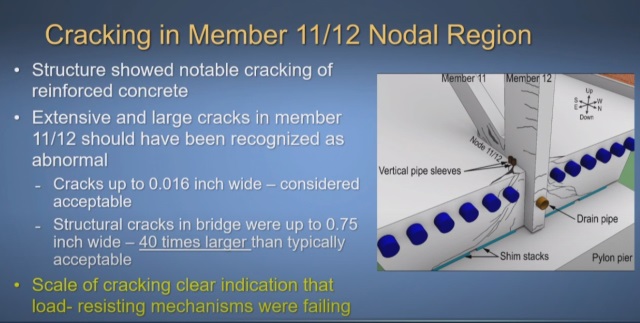Season2-Episode3에는 시공중이던 교량의 붕괴로 6명의 사망자가 발생한 FIU( Florida International University) Pedestrian Bridge 붕괴사고를 다룬다. 최근에 발생한 사고라 연방 교통안전위원회(NTSB, National Transportation Safety Board) 자료도 Youtube에 올라와 있어 상세한 내용 확인이 가능하다.
NTSB 보드 미팅에서 발표된 사고 개요
3시간여 가량의 NTSB 보드 미팅 전체본
전단력을 과소평가하고 전단마찰저항을 과대평가한 교량 엔지니어 잘못이 제일 크다. 설계오류는 그렇다치고 균열폭이 기준에 비해 40배, 균열깊이 75~100mm 구조적 균열이 발생했는데도 즉각적인 안전조치를 취하지 못한 것은 이해가 되지 않는다. 사고 발생전에 기록으로 남아 있는 균열사진들은 보면 이미 교량은 구조적 기능을 발휘할 수 없는 단계에 도달한 상태로 보인다.

NTSB PT 설계 오류중에 Load Factor 0.9를 아닌 1.25를 적용한 것이 error인 이유는 AASHTO LRFD Bridge Design Spec. 5.8.4 Interface Shear Transfer–Shear Friction을 보면 된다. 우리나라 기준으로는 전단마찰에 해당한다.
The nominal shear resistance of the interface plane shall be taken as :
Vn = cAcv + μ(Avf*fy + Pc)
where, Pc : permanent net compressive force normal to the shear plane
여기서 Pc를 크게 하면 전단 저항력이 커지는 것이므로 0.9를 적용하는 것이 불리한 경우인데 1.25를 취해서 Vn을 과대평가한 것이다. 또한, permanent load인 dead load만 적용해야 하는데 live load까지 고려해서 Pc값을 더 크게 만들었다.
‘Error begat error’이란 말이 있듯이 아주 이상한 교량을 만들려고 한 것 부터 첫 단추를 잘못 꿴 것이다. 콘크리트로 트러스교를 만들 수도 있지만 이 교량과 같이 단일면 비대칭 PC 트러스교는 아마도 없을 것이다. 설계 컨셉(design concept)을 한 T.Y.Lin은 설계 요건(design criteria)에 “The bridge superstructure should be primarily structural steel with concrete walking surface. The design should avoid use of non-redundant, fracture critical members”라고 명시하였는데 교량을 선정한 위원회는 외관에만 관심을 가진 모양이다.
Aesthetic Design을 위해 사장교 흉내를 내려고 구조적으로 의미도 없는 주탑 그리고 케이블도 아닌 강재 파이프를 붙여 놓은 교량이다. 인장에 약한 콘크리트로 트러스교를 하려다 보니 prestress가 필요했고 간과했던 수평분력이 cold joint에 전단력으로 작용하여 문제가 되었다. 불행은 미숙한 교량 엔지니어가 이런 메카니즘을 제대로 파악하지 못하고 마지막까지 re-tensioning이라는 잘못된 판단을 한 것이다. OSHA 리포트는 re-tensioning 결과를 수치적으로 설명해 놓았다.
The diagonal axial force in 11 could be resolved into a horizontal force of approximately 1,106 kips without any load factor, and a perpendicular to the shear plane force of 705 kips. The capacity of the joint to resist shear friction was estimated to be 906 kips without any phi factor. The demand is 22% above the available strength. The above condition existed on Saturday, March 10, 2018, until noon of Thursday, March 15, 2018.
On March 13, 2018, and on March 15, 2018, FIGG instructed the contractor to re-tension the two PT bars in diagonal 11 to a force of 280 kips each incrementally with approximately 50 kips re-tension at a time alternating between the upper and lower PT bars. It is understood from Structural Technologies employees that at the time of the collapse, both PT bars were retensioned to the desired force of 280 kips each. The re-tension of March 15, 2018, worsened the situation at the shear plane. On the one hand, it increased the clamping force to 1,006 kips from 705 kips, but on the other hand, the shear friction force was also increased to 1,579 kips from 1,106 kips. The capacity to resist shear friction increased to 1,086 kips. The demand was 45% higher than the available strength without considering any load factors or phi factors. But this capacity did not consider that even prior to re-tensioning, the construction joint was already slipping and failing as shown in a number of figures in the previous sections. The actual capacity would be significantly lower. The failure occurred when the re-tensioning was completed at the lower bars in diagonal 11.
사고 여파가 커서 이제서야 다시 공사를 시작했다고 하는데 이번엔 backstay 없는 강사장교를 채택했다고 한다. 개인적으론 이것도 별로 맘에 들지 않는다.
